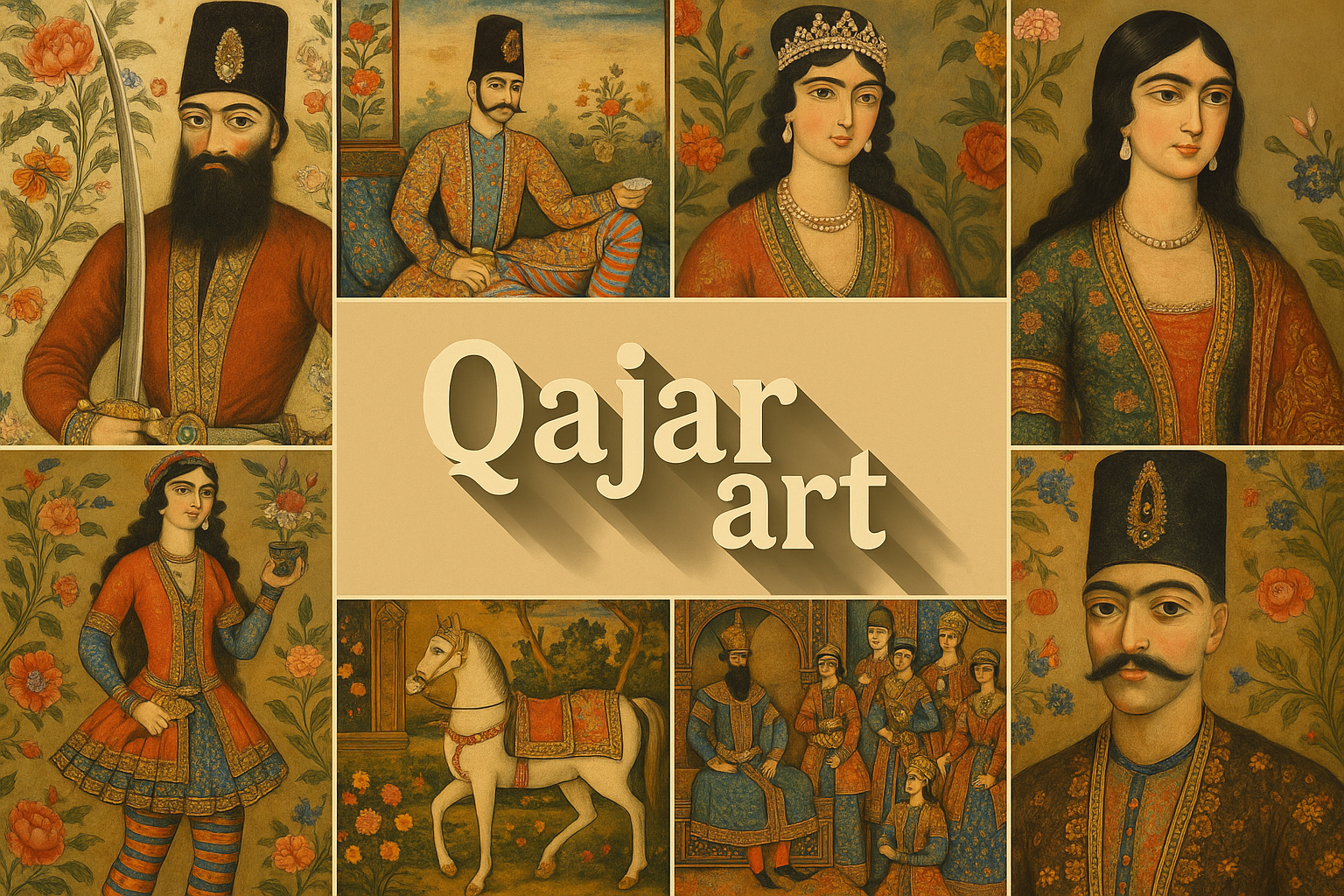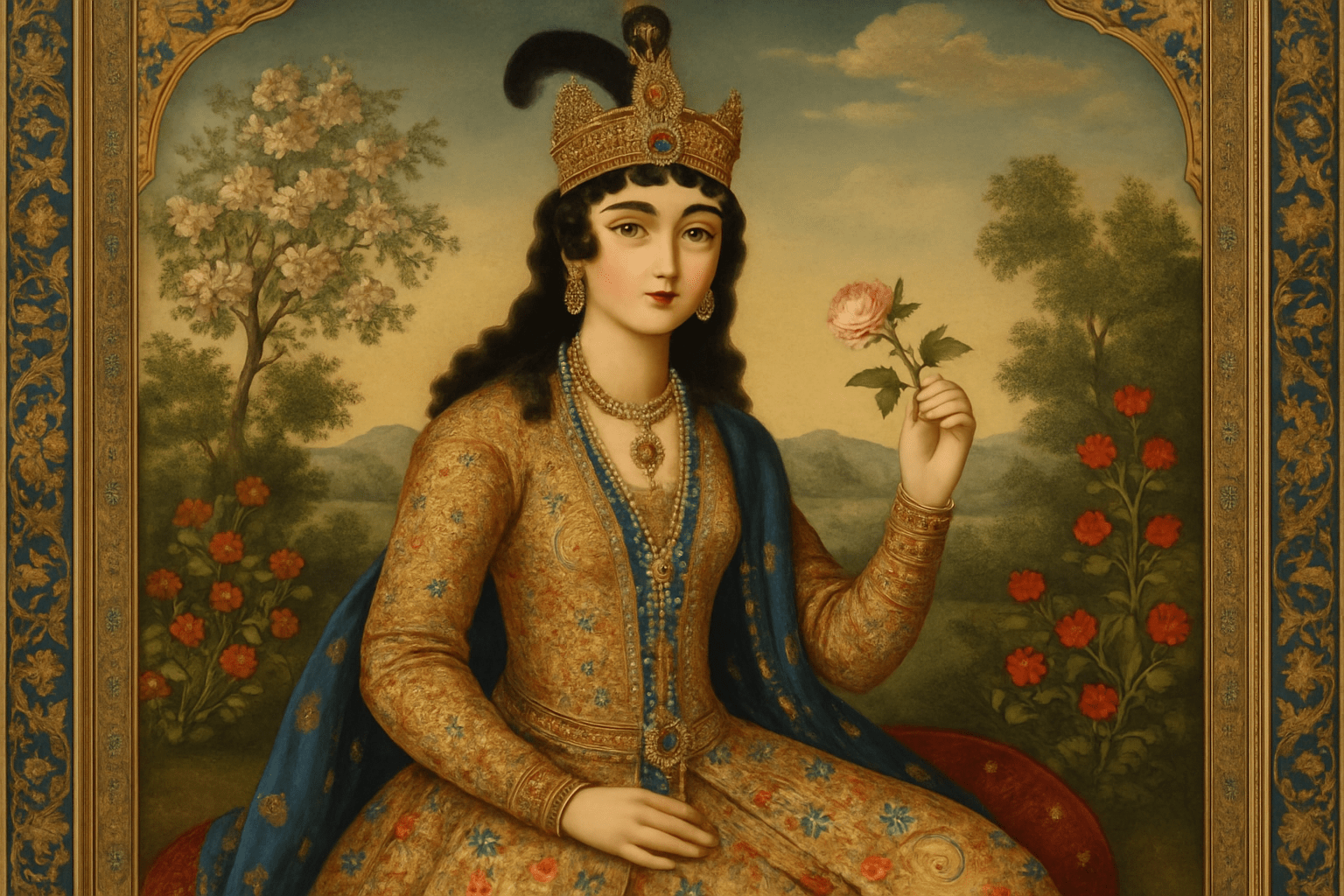
Qajar art
Qajar art is characterized by its use of bright colors and bold patterns. The art style is often described as being “exuberant” and “playful.” Qajar artists often used a variety of techniques to create their art, including painting, sculpture, and calligraphy.
AOI thinking about Qajar art [+_~]-/
Overview and Quickfacts
Qajar art is a style of art that developed in Iran during the Qajar dynasty from 1785 to 1925. The Qajar dynasty was a period of great change in Iran, as the country began to modernize and westernize. This is reflected in the art of the period, which combines traditional Iranian motifs with Western influences. Qajar art is characterized by its use of bright colors, its ornate patterns, and its focus on nature and the human figure.
Can understand it also, as:
Qajar art can be synonymized with Persian art, Iranian art, or Islamic art.
Categorize it as:
Impressionism, Modernism
.: Dreaming :.
holds a HAIKU for the art style
:. Thought is power .:
Detailed Description
Qajar art is a style of Iranian art that developed during the Qajar dynasty, which ruled Iran from 1785 to 1925. The Qajar period was marked by great political and social change in Iran, and the art of the period reflects this change. Qajar art is characterized by its use of bright colors, its ornate style, and its focus on Persian culture and history. Some of the most famous Qajar artists include Mirza Baba, Mohammad Ghaffari, and Mihr ‘Ali. These artists created some of the most iconic Qajar paintings, which often depicted scenes from Persian history and mythology. Qajar art is still highly respected in Iran today, and many of the paintings from this period are on display in museums and galleries across the country.
.. beep, beep, beep ..
<START OF TRANSMISSION>
1. Qajar art is a type of Iranian art that developed during the Qajar dynasty. 2. The Qajar dynasty was founded in 1785 and lasted until 1925. 3. Qajar art is characterized by its use of bright colors and its ornate, decorative style. 4. Qajar art includes painting, calligraphy, architecture, pottery, metalwork, and carpets. 5. Qajar paintings often depict scenes from Iranian history and mythology. 6. Qajar calligraphy is highly stylized and often features intricate patterns. 7. Qajar architecture is characterized by its use of brick and tile, as well as its elaborate decorative elements. 8. Qajar pottery is often brightly colored and decorated with geometric patterns. 9. Qajar metalwork is often made of silver and gold, and is often decorated with enamel. 10. Qajar carpets are often brightly colored and feature intricate patterns. 11. The Qajar period saw the development of the Nastaliq script, which is still used in Iran today. 12. The Qajar period also saw the development of the chador, a type of cloak worn by Iranian women. 13. The Qajar dynasty was founded by Agha Mohammad Khan, who was of Turkmen descent. 14. Agha Mohammad Khan was the first Persian ruler to use the title of Shah. 15. The Qajar dynasty was ended by the Pahlavi dynasty, which came to power in 1925. 16. The Pahlavi dynasty was overthrown by the Islamic Revolution in 1979. 17. The Qajar dynasty was named after the Qajar tribe, which was of Turkmen descent. 18. The Qajar tribe migrated to Iran from Central Asia in the 18th century. 19. The Qajar dynasty was the last Iranian dynasty to rule before the advent of the Pahlavi dynasty. 20. The Qajar dynasty was characterized by political instability and economic decline.
<EOF>
.. robbel bob
Visual Examples from our image gallery
Coming soon, we are so slow .. might never come
Artists, Paintings, and more
(be aware, can be highly speculative)
Artists (be aware, speculation possible):
1. Ali Akbar Sanati (1870-1926) 2. Ahmad Agha Tabrizi (1870-1930) 3. Ahmad Ghaffari (1870-1930) 4. Ali Asghar Jabbari (1870-1937) 5. Ali Dowlatabad (1870-1940) 6. Amir Kabir (1870-1948) 7. Anis ul-Mulk (1870-1949) 8. Arbab Rustam (1870-1951) 9. Ardeshir Mohasses (1870-1952) 10. Bahman Mohasses (1870-1956) 11. Behjat Sadr (1870-1958) 12. Farshchian (1870-1960) 13. Hassan Behzad (1870-1961) 14. Hossein Behzad (1870-1966) 15. Kamal ul-Mulk (1870-1967) 16. Khosrow Hassanzadeh (1870-1969) 17. Mahmoud Farshchian (1870-1969) 18. Mohammad Ghaffari (1870-1969) 19. Mohammad Hassanzadeh (1870-1969) 20. Mohammad Reza Jabbari (1870-1969) 21. Mohammad Reza Shafiei Kadkani (1870-1969) 22. Mohammad-Ebrahim Jabbari (1870-1969) 23. Morteza Katouzian (1870-1969) 24. Najaf Ali Dowlatabadi (1870-1969) 25. Nasrollah Afjei (1870-1969) 26. Parviz Tanavoli (1870-1969) 27. Qasem Hajizadeh (1870-1969) 28. Reza Abbasi (1870-1969) 29. Reza Derakhshani (1870-1969) 30. Sohrab Sepehri (1870-1969)
Artworks (be aware, speculation possible)
1. The Battle of Karbala (1825) by Muhammad Ghaffari 2. The Death of Nader Shah (1829) by Muhammad Ghaffari 3. The Siege of Erzurum (1830) by Muhammad Ghaffari 4. The Siege of Ganja (1831) by Muhammad Ghaffari 5. The Battle of Khoy (1832) by Muhammad Ghaffari 6. The Battle of Tabriz (1833) by Muhammad Ghaffari 7. The Battle of Maragheh (1834) by Muhammad Ghaffari 8. The Battle of Yerevan (1835) by Muhammad Ghaffari 9. The Battle of Nakhchivan (1836) by Muhammad Ghaffari 10. The Battle of Ardabil (1837) by Muhammad Ghaffari 11. The Battle of Khiva (1838) by Muhammad Ghaffari 12. The Battle of Ashgabat (1839) by Muhammad Ghaffari 13. The Battle of Kars (1840) by Muhammad Ghaffari 14. The Battle of Gumbad-e-Kabus (1841) by Muhammad Ghaffari 15. The Battle of Julfa (1842) by Muhammad Ghaffari 16. The Battle of Merv (1843) by Muhammad Ghaffari 17. The Battle of Balkh (1844) by Muhammad Ghaffari 18. The Battle of Sarakhs (1845) by Muhammad Ghaffari 19. The Battle of Khangiran (1846) by Muhammad Ghaffari 20. The Battle of Turkemanchay (1847) by Muhammad Ghaffari 21. The Battle of Herat (1848) by Muhammad Ghaffari 22. The Battle of Kandahar (1849) by Muhammad Ghaffari 23. The Battle of Gulistan (1850) by Muhammad Ghaffari 24. The Battle of Panipat (1851) by Muhammad Ghaffari 25. The Battle of Delhi (1852) by Muhammad Ghaffari 26. The Battle of Resht (1853) by Muhammad Ghaffari 27. The Battle of Shiraz (1854) by Muhammad Ghaffari 28. The Battle of Isfahan (1855) by Muhammad Ghaffari 29. The Battle of Kazvin (1856) by Muhammad Ghaffari 30. The Battle of Tehran (1857) by Muhammad Ghaffari
Epoch
The Qajar art style dates back to the 18th and 19th centuries.
AI ART RESSOURCES (AKA, well Tools)
Helping tools -> predefined search links on other pages:











